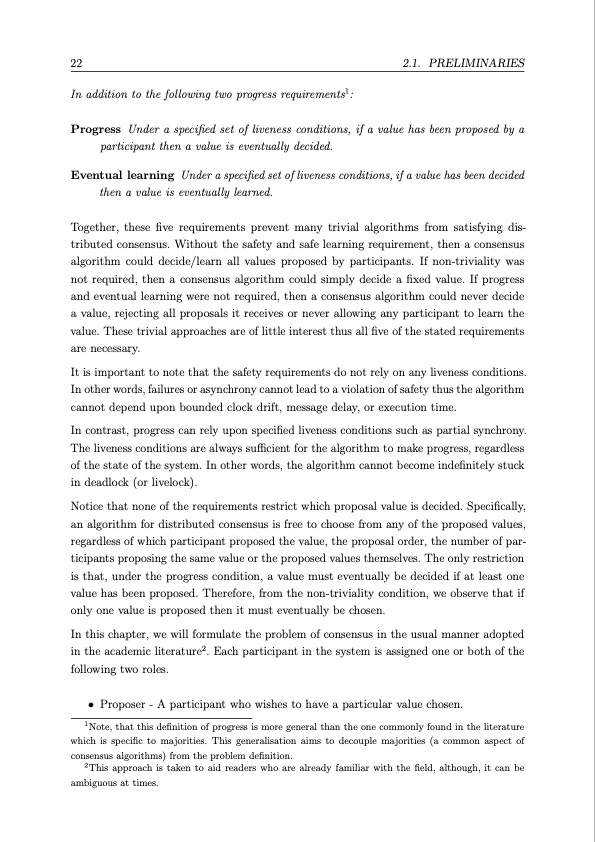
PDF Publication Title:
Text from PDF Page: 022
22 2.1. PRELIMINARIES In addition to the following two progress requirements1: Progress Under a specified set of liveness conditions, if a value has been proposed by a participant then a value is eventually decided. Eventual learning Under a specified set of liveness conditions, if a value has been decided then a value is eventually learned. Together, these five requirements prevent many trivial algorithms from satisfying dis- tributed consensus. Without the safety and safe learning requirement, then a consensus algorithm could decide/learn all values proposed by participants. If non-triviality was not required, then a consensus algorithm could simply decide a fixed value. If progress and eventual learning were not required, then a consensus algorithm could never decide a value, rejecting all proposals it receives or never allowing any participant to learn the value. These trivial approaches are of little interest thus all five of the stated requirements are necessary. It is important to note that the safety requirements do not rely on any liveness conditions. In other words, failures or asynchrony cannot lead to a violation of safety thus the algorithm cannot depend upon bounded clock drift, message delay, or execution time. In contrast, progress can rely upon specified liveness conditions such as partial synchrony. The liveness conditions are always sufficient for the algorithm to make progress, regardless of the state of the system. In other words, the algorithm cannot become indefinitely stuck in deadlock (or livelock). Notice that none of the requirements restrict which proposal value is decided. Specifically, an algorithm for distributed consensus is free to choose from any of the proposed values, regardless of which participant proposed the value, the proposal order, the number of par- ticipants proposing the same value or the proposed values themselves. The only restriction is that, under the progress condition, a value must eventually be decided if at least one value has been proposed. Therefore, from the non-triviality condition, we observe that if only one value is proposed then it must eventually be chosen. In this chapter, we will formulate the problem of consensus in the usual manner adopted in the academic literature2. Each participant in the system is assigned one or both of the following two roles. • Proposer - A participant who wishes to have a particular value chosen. 1Note, that this definition of progress is more general than the one commonly found in the literature which is specific to majorities. This generalisation aims to decouple majorities (a common aspect of consensus algorithms) from the problem definition. 2This approach is taken to aid readers who are already familiar with the field, although, it can be ambiguous at times.PDF Image | Distributed consensus

PDF Search Title:
Distributed consensusOriginal File Name Searched:
UCAM-CL-TR-935.pdfDIY PDF Search: Google It | Yahoo | Bing
Cruise Ship Reviews | Luxury Resort | Jet | Yacht | and Travel Tech More Info
Cruising Review Topics and Articles More Info
Software based on Filemaker for the travel industry More Info
The Burgenstock Resort: Reviews on CruisingReview website... More Info
Resort Reviews: World Class resorts... More Info
The Riffelalp Resort: Reviews on CruisingReview website... More Info
| CONTACT TEL: 608-238-6001 Email: greg@cruisingreview.com | RSS | AMP |